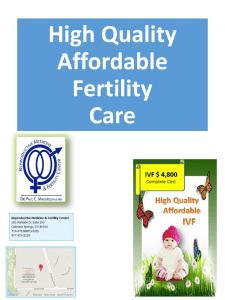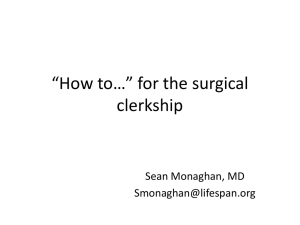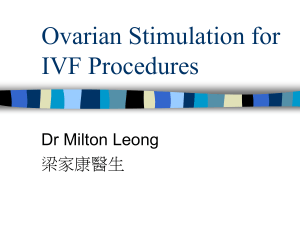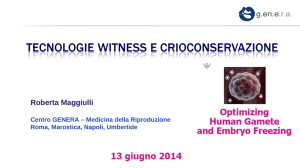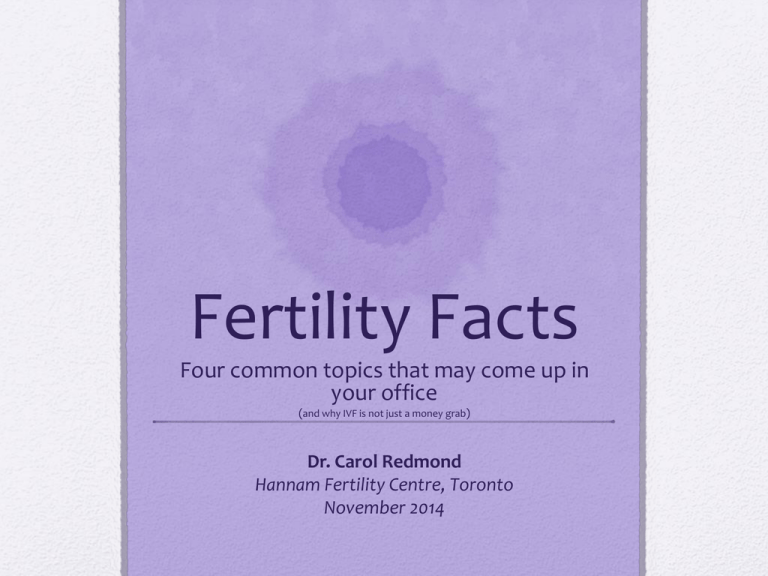
Fertility Facts
Four common topics that may come up in
your office
(and why IVF is not just a money grab)
Dr. Carol Redmond
Hannam Fertility Centre, Toronto
November 2014
The Questions
1. “Can you check my fertility?”
2. “Can I freeze my eggs?”
3. “I’m not getting pregnant, can I just take
Clomid?”
4. “If Clomid doesn’t work, what does help?
How does IVF work?”
“Can you check my fertility?”
• History
•
•
•
•
AGE
Regular cycles
History of STI
Family history of early
menopause
• Symptoms of
endometriosis
http://whattoexpectwhenyouarenot.wordpress.com/
Ultrasound
Endometrioma
PCO occur in 1/3 of
women without PCOS
Submucosal Fibroid
http://www.fornewyou.com/Endometrioma-Cyst
http://www.medscape.com/viewarticle/491677_2
http://tatjana-mihaela.hubpages.com/hub/polycysticOS
Age
• Egg quality declines
with age
• Egg quality is the gate
keeper to fertility
• If all else is normal, egg
quality decides cycle
fecundity and success
rates with ART
http://nymag.com/news/features/mothers-over-50-2011-10/
Myths and Misconceptions
• “My cycles are regular so my fertility is fine”
• “I’ve stayed fit and healthy so my fertility has been
maintained”
• “My day 3 FSH is good so my fertility is still fine”
• “All the women in my family get pregnant easily
over age 40”
• “I got pregnant easily the first time so I will be
fine”
Age
• Daniluk surveyed 1021 women age 20-40 (2010)
• Most expected to have more than 1 child in their
3rd or 4th decade
• 70% expected to start after age 30
• 60% wanted 2 children
• 20% wanted more than 2 children
• Most thought health was a better predictor of
fertility than age
Age
• The first sign of
aging of the eggs is
infertility
• There are no other
clinical or
biochemical signs
• The first clinical sign
of aging is a
shortening of the
cycle (Lambalk, 2009)
Odds of Natural Conception
Age of marriage and
percentage of women not
using contraception but
childless (Menken, 1986)
Estimated age-related
chances of conception
within 12 months resulting
in live birth (Leridon, 2004)
80%
80%
60%
60%
40%
40%
20%
20%
0%
0%
20-24 25-29 30-34 35-39 40-44
Age
30
35
Age
40
Age
• So if eggs are the gate keeper, can we assess
egg quality?
NO!
Age
• Egg quality can only be assessed at the time of IVF
• What is “ovarian reserve testing” testing then?
• This is testing egg quantity
• Egg quantity declines with age
• If number of eggs is declining, it is a reasonable
assumption that another aging process – declining
egg quality – is also ongoing
Tests of Ovarian Reserve
1. AMH
2. AFC (Antral Follicle Count)
3. Day 3 FSH
Tests of Ovarian Reserve
1. AMH
• Produced by pre-antral and small antral follicles
• The serum level reflects the number of small
follicles in the ovaries
• The absolute level does not predict fertility
• The ideal range is 15-30 pmol/L
Does Low AMH Level Matter?
• 1/3 of young women (age 21) will have an AMH level <12 pmol/L
(Lund Kristensen, 2012)
• 26% of potential egg donors showed an AMH level in the
low range (Gleicher, 2010)
• I surveyed 94 women presenting to HFC for donor sperm
Age
% with AMH <15
Pregnancy Rate
<35
30%
Did not affect
35-40
60%
Did not affect
>40
72%
Pregnancy rate 50% lower
30% with good AMH
Lowest AMH level with a conception (age 42)
was 3 pmol/L (3rd try)
How Do We Use AMH Levels?
• Changes in AMH may matter
• A dropping AMH level suggests declining egg numbers,
which indicates ovarian aging, which suggests egg aging
• AMH predicts ovarian responsiveness
• AMH is a good predictor of the ability of the ovary to
“superovulate”
Tests of Ovarian Reserve
2. Antral follicle count
• Also measures the reserve of small follicles, but very
observer dependent
3. FSH
• This is the last thing to change as the ovary ages
• Significant decline in ovarian reserve can occur in
the presence of a normal FSH level
• High FSH level strongly predicts an inability of the
ovary to “superovulate”
“How can I tell if I’m fertile?”
• Try to get pregnant
• A low AMH level at
any age does not
preclude pregnancy
• A normal AMH level
does not imply
normal fertility
http://pregnancytips.org/getting-pregnant/how-to-get-pregnant/trying-to-get-pregnant/
“Can I freeze my eggs to
be safe?”
• Egg freezing is now a reliable
technology with the advent of
egg vitrification
• Most of the babies are from
frozen donor eggs
• A survey in 2012 of the 7 USA
Commercial Egg Banks
revealed that 8780 frozen
eggs had generated 602
pregnancies (6.8%) (Quaas, 2013)
http://retrievefreezerelax.com/egg-freezing-basics/
Egg Freezing
• We can expect a thaw rate of 86%
• And a fertilization rate of 76%
• So 10 eggs on average will generate 3 blastocysts
• Implantation rate per embryo from fresh eggs:
Age
Success
<35
37%
35-37
28%
38-40
18%
41-42
10%
>42
4%
SART data, 2012, (n=165,172 cycles)
Egg Freezing
• The success rate will depend on the quality of
the eggs being frozen
• This will decline with age
Age
30-36 (n=11)
37-39 (n=11)
Survival
83%
71%
Fertilization
70%
62%
% day 3 embryos
55%
40%
# clinical pregnancy
64%
27%
% eggs to LB
8%
3%
Chang, 2013
Egg Freezing
• This is where AMH levels fit in
• The AMH level is a reasonable predictor of egg
yield with IVF
AMH 6 pmol/L
3-6 eggs
AmH 12 pmol/L
6-12 eggs
• A 37 year old with an AMH of 7?
• Maybe 3 eggs to freeze, which may make 1 embryo,
if all three eggs thaw and fertilize, with IR of 27%
Egg Freezing
• Things to consider:
• Effort – requires ovarian stimulation and egg retrieval
• Very little data yet on thawing and pregnancy rates
(CCRM has had 47 thaws of non donor frozen eggs in
the past few years (personal communication, 2014)
http://www.bodyconfidential.co.uk/Health/Egg-Freezing-A-21st-Century-Dilemma
Egg Freezing
• Things to consider (cont):
• Cost!
•Retrieving
eggs and
freezing
$8,000
$5,000
•Medications
•Yearly
storage
costs
$250
$2,125
•Thawing
$17,175
•Fertilization
with ICSI
$1,800
•Total Cost
Embryo Banking
• This is a more certain
option
• Proceed with IVF, fertilize
eggs, make embryos,
screen embryos with PGS
for aneuploidy
• Each euploid embryo has
a 60-70% chance of a live
birth – independent of
age at transfer
http://www.biopoliticaltimes.org/article.php?id=5833
“I’m not getting pregnant,
can’t I just take Clomid?”
The Miracle Drug Clomid
• First get a diagnosis
• Ovulation
• Semen analysis
• Sonohysterogram to
check uterus and tubal
patency
http://www.kinetic-international.net/Oral_clomid50.html
Myths and
Misconceptions
• “We didn’t have sex on exactly
the right day”
• “I know it’s because I’ve been
stressed”
• “The sperm leaks out”
• “I need to lie there for ½ hour”
• “We are having sex too
often/not often enough”
• “It doesn’t matter that we
smoke – all our friends do and
they have kids”
http://raspberrytruffles.org/trying-is-fun/
Clomid
• Estrogen receptor blocker
• Can induce the development of more than 1
egg per month (40% of cycles)
• 40% of women have anti-estrogenic side
effects (thin endometrium, poor cervical
mucus) which impede pregnancy
• Nuisance side effects: headaches, visual
flashes, hot flushes, moodiness
Clomid
• How well does it work?
• Not very…
Clinical Pregnancy Rate Per Cycle
<35
36-37 38-40
>40
CR (n=537)
9%
9%
5%
0%
Dovey, 2013 (n=4100)
11%
9%
7%
4%
What Does Work?
Ongoing Pregnancy Rate Per Cycle
100%
80%
Age
<35
60%
35-37
40%
38-40
>40
20%
0%
Intercourse
IUI
IVF Hannam
PGS CCRM
Hannam Fertility Center, 2014
What Does Work?
Medicated IUI with 2-4 Follicles
Pregnancy Rate Per Cycle
100%
80%
Age
<35
60%
35-37
40%
38-40
>40
20%
0%
1
2
3
IUI Cycle #
Hannam Fertility Center, 2014
FSH Superovulation and IUI
• FSH
•
•
•
•
•
Daily injections for 10-13 days
Daily monitoring with blood & USS
Costly
20% of pregnancies are twins
1% are triplets
IVF
• Two multi-centre prospective randomized
trials in a population of patients with
unexplained infertility and unsuccessful Clomid
and IUI looked at proceeding to FSH and IUI
then IVF as needed, or straight to IVF
• Both showed a higher pregnancy rate
achieved in fewer cycles and at a lower cost if
the patients proceeded directly to IVF
• (FORT-T trial, 2014, & FASTT trial, 2010)
IVF
• 272 women COH & IUI
•
•
•
•
CLBR after 2 cycles 27%
Twins 13%
1 triplets
1 quadruplet
• 176 women IVF
• LBR after 1 cycle 39%
• Twins 10%
http://www.co-parentmatch.com/In-Vitro-Fertilization-IVF.aspx
• (Chambers, 2010)
IVF
IVF & ICSI with 2 Embryos Transferred
100%
80%
Age
<35
60%
35-37
40%
38-40
20%
>40
0%
0
1
2
Blastocysts Produced
3+
Hannam Fertility Center, 2014
IVF
• National Health Service funded IVF
• < 40 years of age, 3 IVF cycles
After 1st cycle
30% pregnant
After 2nd cycle
53% pregnant
After 3rd cycle
63% pregnant
• Took less than 2 years to achieve 3 cycles
(Goswami, 2013)
IVF with PGS
• PGS = pre-implantation genetic screening for
aneuploidy
• Euploidy rate
• 56% if excellent blastocyst morphology
• 39% if good blastocyst morphology
• 42% if average blastocyst morphology
• 25% if poor blastocyst morphology
• (Capalbo, 2014)
IVF & PGS Case Studies
• 39-40 year old woman
with unexplained
infertility
• Over 4 IVF cycles she
generated
• 33 year old woman
with unexplained
infertility
• Over 1 IVF cycle she
generation
106 eggs
15 eggs
31 blastocysts
8 blastocysts
8 euploid
1 euploid
IVF & PGS Case Studies
• 40 year old trying for 2 years
IUI X 1
Clomid & IUI X 1
FSH & IUI X 2
IVF 4 blastocysts no pregnancy (took 4
months)
IVF 5 blastocysts all aneuploid
Donor egg
IVF & PGS
• Recurrent implantation failure
43 Women PGS
1 euploid
68%
33 Women no PGS
1-2 blastocysts
21%
45 Good Prognosis
1 euploid
70%
• (Greco, 2014)
IVF & PGS & Miscarriage
• PGS is the answer to most miscarriage
(Benner, 2012)
IVF & PGS & Miscarriage
Case Study
• 40 year old TDI X 8
• IVF
5 blastocysts
•Transfer 1
miscarriage
•Transfer 1
miscarriage
•Transfer 1
no pregnancy
•3 embryos did not
survive thawing
9 months later,
repeat IVF
•No eggs
3 months later
•Day 3 FSH 19
IVF
• Women for donor sperm over age 40
TDI x 6
24%
vs.
IVF & ICSI x 3
28%
• Nearly all successful IVF was in first attempt
• Single IVF = 6 cycles of TDI
• (De Brucker, 2013)
Summary
1.
Age remains the best predictor of fertility
2. AMH levels do not predict fertility
3. Serial AMH levels may have value
4. Egg freezing is great technology (when applied to
young women)
5. If you are sub-fertile, there is no simple approach
that also has a great success rate
6. IVF, particularly with PGS, if highly effective, but not
simple or natural
Questions?
You are invited to contact me anytime at
carol.redmond@hannamfertility.com
http://www.cartoonstock.com/directory/i/infertility.asp
References
•
Benner, A. 2012. Evaluation of 571 IVF cycles and 4873 embryos using 23-chromosome SNP
(single nucleotid polymorphism) microarray PGS. Fertil & Steril 97(3)Supp:S23.
•
Capalbo, A., Rienzi, L., Cimadomo, C, Maggiulli, R., Elliott, T., Wright, G., Nagy, Z., & Ubaldi, F.
2014. Correlation between standard blastocyst morphology, euploidy and implantation: an
observational study in two centers involving 956 screened blastocysts. Hum. Reprod
29(11):234-9.
•
Chambers, G., Sullivan, E., Shanahan, M., Ho, M., Priester, K., & Chapman, M. 2010. Is in vitro
fertilisation more effective than stimulated intrauterine insemination as a first-line therapy for
subfertility? A cohort analysis. Aust N Z J Obstet Gynaecol 50(3):280-8.
•
Chang , C., Elliott, T., Wright, G., Shapiro, D., Toledo, A., & Nagy, Z. 2013. Prospective controlled
study to evaluate laboratory and clinical outcomes of oocyte vitrification obtained in in vitro
fertilization patients aged 30 to 39 years. Fertil & Steril 99(7):1891-7.
•
Daniluk, J. Koert, E., & Cheung, A. 2011. Childless women’s knowledge of fertility and assisted
human reproduction: identifying the gaps. Fertil & Steril 97(2):420-6.
References
•
De Brucker, M., Camus, M., Haentjens, P., Verheyen, G., Collins, G., & Tournaye, H. 2013.
Assisted reproduction using donor spermatozoa in women aged 40 and above: the high road
or the low road? Repro BioMed Online 26(6):577-85.
•
Gleicher, N. Can egg donor selection be improved - a pilot study. Reprod Biol Endocrinol 8:76.
•
Goswami, M., Hyslop, L., & Murdoch, A. 2013. NHS-funded IVF: consequences of NICE
implementation. Hum Fertil 16(2):121-7.
•
Greco, E., et al. 2014. Comparative genomic hybridization selection of blastocysts for repeated
implantation failure treatment: a pilot study. Biomed Res Int. 2014:457913.
•
Lambalk, C. Van Disseldorp, J., De Koning, C., & Broekmans, F. 2009. Testing ovarian reserve to
predict age at menopause. Maturitas 63(4):280-91.
•
Leridon H. 2004. Can assisted reproductive technlogy compensate for the natural decline in
fertility with age? A model assessment. Hum Reprod 19:1548-53.
References
•
Lund Kristensen, S. 2012. The association between circulating levels of AMH and follicle
number, androgens, and menstrual cycle characteristics in young women. Fertil & Steril
97(3):779-785.
•
Menken J., Trussell, J., & Larsen, U. 1986. Age and infertility. Science 233:1389-94.
•
Quaas, A., Melamed, A., Chung, K., Bendikson, K., & Paulson, R. 2013. Egg banking in the
United States: current status of commercially available cryopreserved oocytes. Fertil & Steril
99(3):827-31.


